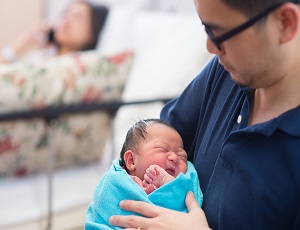Paternity Leave in China: Regional Policies and Differences

By Dezan Shira & Associates
Editor: Jake Liddle
China does not have unified legislation for paternity leave. Paternity leave policies are implemented on a municipal or provincial level by local population and family planning regulations, and can vary from anywhere between zero to 30 days.
In most cases, there are no standard paternity leave policies, but ‘late birth incentive leave’ (part of the government’s incentives scheme to delay births and encourage single child birth) can be shared by a mother and father. A woman giving birth at the age of 24 years qualifies as ‘late birth’. In many cities, when a couple has only one child, the father is entitled to a few days off as well. In this article, we discuss the local regulations on this topic in China’s major cities.
Beijing
Beijing does not have any paternity leave policies. However, according to Beijing family planning regulations, the additional late birth incentive leave of 30 days awarded to mothers can also extend to fathers. It must be noted that this leave cannot be mutually enjoyed. In addition, if the father does not choose to take these 30 days, he may enjoy an additional one month wage bonus according to the mother’s basic salary.
Shanghai
Like Beijing, fathers in Shanghai do not enjoy any standard paternity leave. According to the Shanghai municipal population and family planning regulations, apart from the national standard maternity leave, a mother of late birth may add 30 days of late birth incentive leave, and their spouse may take three days ‘late birth nursing leave’.
Hong Kong
Male employees in Hong Kong who hold a Hong Kong birth certificate, proof of parenthood and are hired under a continuous contract are eligible to apply for paid paternity leave of three days. These three days may be taken consecutively or separately during the four weeks leading up to the expected delivery date or during 10 weeks after birth.
 RELATED: Human Resource Services from Dezan Shira & Associates
RELATED: Human Resource Services from Dezan Shira & Associates
Tianjin
According to the Tianjin municipal population and family planning regulations, a standard of seven days leave is offered to a father who is married to a civil servant or member of a state owned enterprise.
Dongguan, Zhongshan, Shenzhen
For parents who hold an ‘honorary single child certificate’, a father may take 10 days of paid ‘nursing leave’.
Hangzhou, Ningbo
According to the Zhejiang population and family planning regulations, a father of late birth may enjoy seven days of nursing leave.
Qingdao
Shandong’s policy for paternity leave is the same as Zhejiang province, allowing seven days of nursing leave for a father of late birth.
Dalian
According to the Liaoning population and family planning regulations, a father of late birth who holds an ‘honorary single child certificate’ may enjoy 15 days of nursing leave.
Takeaways for employers and employees
Paternity policies evidently vary vastly across China. For employers, it is important to be aware of these regional differences, especially when operating in different locations.
Paternity leave length and pay is determined by location of employment and not by an employee’s place of birth. In certain locations, it can also be subject to the decision of the employer. There are no existing paternity leave policies for foreign workers in China; whether or not paternity leave can be taken is therefore at the discretion of the employer.
|
Asia Briefing Ltd. is a subsidiary of Dezan Shira & Associates. Dezan Shira is a specialist foreign direct investment practice, providing corporate establishment, business advisory, tax advisory and compliance, accounting, payroll, due diligence and financial review services to multinationals investing in China, Hong Kong, India, Vietnam, Singapore and the rest of ASEAN. For further information, please email china@dezshira.com or visit www.dezshira.com. Stay up to date with the latest business and investment trends in Asia by subscribing to our complimentary update service featuring news, commentary and regulatory insight. |
![]()
 Human Resources and Payroll in China 2015
Human Resources and Payroll in China 2015
This edition of Human Resources and Payroll in China, updated for 2015, provides a firm understanding of China’s laws and regulations related to human resources and payroll management – essential information for foreign investors looking to establish or already running a foreign-invested entity in China, local managers, and HR professionals needing to explain complex points of China’s labor policies.
 Employing Foreign Nationals in China
Employing Foreign Nationals in China
In this issue of China Briefing, we have set out to produce a guide to employing foreign nationals in China, from the initial step of applying for work visas, to more advanced subjects such as determining IIT liability and optimizing employee income packages for tax efficiency. Lastly, recognizing that few foreigners immigrate to China on a permanent basis, we provide an overview of methods for remitting RMB abroad.
 Adapting Your China WFOE to Service China’s Consumers
Adapting Your China WFOE to Service China’s Consumers
In this issue of China Briefing Magazine, we look at the challenges posed to manufacturers amidst China’s rising labor costs and stricter environmental regulations. Manufacturing WFOEs in China should adapt by expanding their business scope to include distribution and determine suitable supply chain solutions. In this regard, we will take a look at the opportunities in China’s domestic consumer market and forecast the sectors that are set to boom in the coming years.
- Previous Article How to Hire Part Time Employees in China
- Next Article Z and M Visa Issues: Seven Things to be Aware of When Employing Foreign Staff in China

































